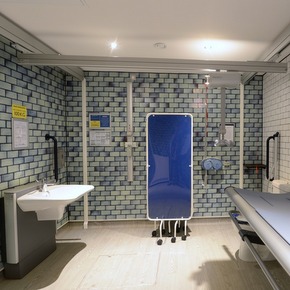
Changing toilet standards: new British Standard
 GUEST BLOG: Claire Haymes, away from home co-ordination at Closomat explains how ‘Best practice’ guidelines on assisted accessible toilet provision have changed, extending the remit to apply to even more locations which people visit.
GUEST BLOG: Claire Haymes, away from home co-ordination at Closomat explains how ‘Best practice’ guidelines on assisted accessible toilet provision have changed, extending the remit to apply to even more locations which people visit.
New British Standard BS8300:2018
The new British Standard BS8300:2018 addressing building accessibility has just been published. Now, it has expanded on where facilities should be provided, and specifically itemises large commercial retail premises and town centres as venue types that should provide Changing Places Toilets. The expansion supplements the previous advisory venues that include:
– transport hubs
– tourist attractions
– motorway services
– healthcare facilities
– cultural centres
– shopping centres,
– key buildings in town centres
– educational establishments
– visitor attractions
– sport and leisure venues, stadia and large hotels
The addition means that most places people go to spend time are now being encouraged, if building or refurbishing, to optimise their accessibility.
Compliant Changing Places Toilet
The updated Standard has also revised the actual specification of a compliant Changing Places Toilet. It should still be a minimum 3m x 4m, with a ceiling height of 2.4m, and include at the very least a peninsular WC, ceiling track hoist, adult sized height adjustable changing bench, privacy screen, washbasin. Now, however, it is optional whether a shower is incorporated.
In our experience, as the biggest supplier and installer of Changing Places Toilets, historically, more often than not, the shower was often omitted anyway. In our experience, in practice, it is the WC, hoist and changing bench that make a life-changing difference to the potentially 14million people who need any or all of the criteria included in a Changing Places Toilet.
For anyone who needs either at least one carer, or who can’t get out of their wheelchair unaided, or who has continence issues, conventional wheelchair accessible toilets are inadequate.
But it’s not just the disabled person the facilities affect. The same applies to anyone who cares for someone disabled: what happens if the carer needs the loo? Do they abandon the person- be they child or adult- outside the toilet whilst they go?
The new Standard comes as the campaign for Changing Places Toilets is enjoying much high profile publicity. The campaign has been featured on national TV, radio and in national newspapers over the past three months. It is being publicised by disabled personalities. It is being discussed in Parliament.
However provision of Changing Places Toilets is still, even with the new Standard, still only advisory, the best practice. There are still only about 1000 across the country, 10 years after the concept was first launched. There is no legal obligation to provide them.
There is a humanitarian obligation, as desirable under equality, ethical considerations. There is also a strong financial argument to provide them. Government figures claim disabled people spend £249billion a year! 20% of the UK population is disabled.
Let’s hope the new BS8300:2018 heralds a new era in developing an inclusive society. Let’s hope other big brands follow the lead of IKEA, JD Wetherspoon, MOTO, Merlin Entertainment, Roadchef, to name a few, and commit to providing Changing Places as far and as widely as practically possible.
Next time you’re out and about-whether it is doing the weekly shop, going to the movies, or having a meal with friends-, and need the loo, maybe take a moment to think about how easy it is for you to find, use one, compared to the millions who need a Changing Places. Next time you’re involved in designing, building, refurbishing, remember that thought.
* Potential users of a wheelchair-accessible toilet with space, bench and hoist eg Changing Places include:
– 1.5m wheelchair users
– 6.5 million people who have either bladder or bowel incontinence
-1.5million people with a learning disability
– 1.2million people living with stroke
– 62,000 amputees
– 30,000 people with cerebral palsy
– 13,000 people with acquired brain injuries
– 8,500 people with multiple sclerosis
– 5000 people with motor neurone disease
– 8,000 people with spina bifida
– 120,000 people with a stoma
– 100,000 people with muscular dystrophies
– 3.8million adults morbidly obese
– 0.8million disabled children
– 8.7million people with osteoarthritis
– 400,000 people with rheumatoid arthritis
Latest news

26th July 2024
Enfield Speciality Doors completes world-class project for Atlas Copco HQ
A rundown office and warehouse building completely transformed into a modern headquarters for Atlas Copco has been fitted with more than 120 internal fire doors from Enfield Speciality Doors.
Posted in Access Control & Door Entry Systems, Articles, Building Industry News, Building Products & Structures, Building Systems, Case Studies, Doors, Interior Design & Construction, Interiors, Posts, Restoration & Refurbishment, Retrofit & Renovation, Security and Fire Protection, Sustainability & Energy Efficiency, Timber Buildings and Timber Products, Wooden products
26th July 2024
Abloy UK launches new white paper
Abloy UK, a leading provider of security and access control solutions, has launched a new white paper.
Posted in Access Control & Door Entry Systems, Architectural Ironmongery, Articles, Building Industry News, Building Products & Structures, Building Services, Doors, Facility Management & Building Services, Health & Safety, Information Technology, Innovations & New Products, Publications, Research & Materials Testing, Security and Fire Protection
26th July 2024
MCRMA Member Profile: David Roy, Director of Roofconsult
David Roy of MCRMA member company Roofconsult has more than 50 years’ experience to draw upon working in the building envelope sector and a unique perspective on how it has changed in that time.
Posted in Articles, BIM, Infrastructure & CAD Software, Building Associations & Institutes, Building Industry News, Building Products & Structures, Building Services, Building Systems, Cladding, Information Technology, Restoration & Refurbishment, Retrofit & Renovation, Roofs, Walls
26th July 2024
Strand: Enhancing Door Functionality and Safety
Craig Fox, Sales Director for Strand Hardware, outlines how door industry professionals might apply door limiting stays…
Posted in Architectural Ironmongery, Articles, Building Industry News, Building Products & Structures, Building Services, Doors, Facility Management & Building Services, Health & Safety, Restoration & Refurbishment, Retrofit & Renovation
 Sign up:
Sign up: